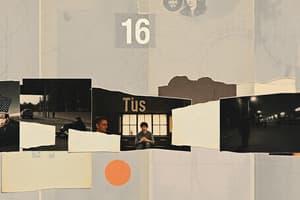Podcast
Questions and Answers
According to the cognitive instability hypothesis, what is the primary reason memories from periods of significant change are more easily encoded?
According to the cognitive instability hypothesis, what is the primary reason memories from periods of significant change are more easily encoded?
- The brain suppresses old memories to make space for new ones.
- Stable memories are more relevant.
- Emotional memories are the key to encoding well.
- Instability enhances memory formation due to the novel and cognitive processing required. (correct)
How does cortisol affect memory encoding, according to the information provided?
How does cortisol affect memory encoding, according to the information provided?
- Cortisol enhances memory consolidation, particularly by activating the amygdala. (correct)
- Cortisol primarily impairs memory consolidation due to its disruptive effects.
- Cortisol has no direct impact on memory encoding.
- Cortisol only affects the encoding of neutral stimuli.
How does the 'weapon focus' effect impact memory recall in eyewitness situations?
How does the 'weapon focus' effect impact memory recall in eyewitness situations?
- Witnesses tend to remember details of the surroundings but miss details of the person.
- Witnesses don't recall much due to the focus on the weapon.
- Witnesses remember details of the weapon but recall all of the events that occurred.
- Witnesses focus on the weapon, impairing their ability to remember details about the person holding it. (correct)
What is the main finding of Neisser and Harsch's (1992) study of the Challenger disaster regarding flashbulb memories?
What is the main finding of Neisser and Harsch's (1992) study of the Challenger disaster regarding flashbulb memories?
How does the 'wrong time slice hypothesis' explain inaccuracies in memory recall?
How does the 'wrong time slice hypothesis' explain inaccuracies in memory recall?
In the context of memory construction, what is the role of 'War of the Ghosts' experiment?
In the context of memory construction, what is the role of 'War of the Ghosts' experiment?
How do schemas impact memory recall?
How do schemas impact memory recall?
What does the misinformation effect, studied by Elizabeth Loftus, primarily demonstrate about memory?
What does the misinformation effect, studied by Elizabeth Loftus, primarily demonstrate about memory?
In the context of eyewitness testimony, what is the primary concern regarding the use of line-ups?
In the context of eyewitness testimony, what is the primary concern regarding the use of line-ups?
How does providing feedback to an eyewitness after they have made an identification from a lineup affect their confidence?
How does providing feedback to an eyewitness after they have made an identification from a lineup affect their confidence?
Flashcards
Autobiographical Memory
Autobiographical Memory
Memory composed of facts, events, and personal identity.
Reminiscence Bump
Reminiscence Bump
Tendency to recall events from ages 10-30.
Infantile Amnesia
Infantile Amnesia
Lack of memories from early childhood.
Self-Image Hypothesis
Self-Image Hypothesis
Forming self-identity through memories, tastes and preferences developed around ages 10-30
Signup and view all the flashcards
Emotional Memory
Emotional Memory
Memories are highly emotionally charged and processed in the amygdala.
Signup and view all the flashcards
Weapon Focus
Weapon Focus
The tendency to focus on a weapon during a crime, impairing memory for other details.
Signup and view all the flashcards
Flashbulb Memories
Flashbulb Memories
Vivid and detailed emotional memories, but not always accurate.
Signup and view all the flashcards
Memory Construction
Memory Construction
Actively reconstructing memories using knowledge to fill in gaps.
Signup and view all the flashcards
Misinformation Effect
Misinformation Effect
Misleading information or suggestions affect memory recall.
Signup and view all the flashcards
Weapon Focus Eyewitness
Weapon Focus Eyewitness
Tendency to focus on a weapon during a crime impacting memory of other details.
Signup and view all the flashcardsStudy Notes
- Autobiographical memory is composed of facts and events that are both semantic and episodic, giving meaning to your life story and identity.
- Autobiographical memory is not evenly distributed throughout life but concentrated in specific time periods.
- Autobiographical memory includes what has happened in life as well as semantic (knowledge and concepts) and episodic (experienced events) memories.
- The reminiscence bump is a tendency to recall events from ages 10-30 (Rubin et al., 1998).
- Infantile amnesia is the lack of memories from early childhood, due to the brain learning regularities instead of forming strong memories.
- The self-image hypothesis: people form self-identity, tastes, and preferences, listing memories from when growing up and after doing "I am" exercises to remember defining ages 10 to 30.
- The cognitive instability hypothesis posits memories are better when transitioning from instability to stability, due to rapid changes in schools, friends, jobs, marriage, and children, which create instability.
- People who immigrated to the U.S. at ages 20-24 have more memories from that time compared to those who emigrated at ages 34-35.
- Massive changes encode memories better because they are novel and require cognitive processing.
- The cultural life script hypothesis involves knowledge and episodic moments of events typical for everyone, like first dates, graduation, marriage, and having a first child, providing a template for what to expect in life.
- Emotional memories are highly emotionally charged.
- The amygdala facilitates emotional processing and connects with memory formation in the hippocampus.
- Individuals with normal amygdalas remember emotional stimuli better than mundane stimuli (Cahill et al., 2003).
- High cortisol levels caused by stress activate the amygdala and lead to better memory encoding.
- Weapon Focus (Stanny and Johnson, 2000): When someone holds a weapon, attention is focused on the weapon rather than the person's details.
- Weapon focus is a Bottom-up attention capture.
Flashbulb Memories
- Flashbulb memories are vivid and detailed emotional memories.
- They are believed to be stable (Brown and Kulik, 1977)
- Neisser and Harsch (1992) found that 75% of memories about the Challenger Disaster did not match the original memory.
- Talarico and Rubin (2003) found that recall details were just normal memories and that Flashbulb memories of the event and the belief that it happened like that increases with time.
- The wrong time slice hypothesis suggests memories jumble up when you rehearse different sources, or can be a misattribution of source.
- The narrative rehearsal hypothesis posits that memories are refreshed and rehearsed every time the event is seen, resulting in different contexts and mixed details.
- Memory can be influenced by the media
- 44% remember seeing a car chase related to Princess Diana (Ost et al, 2002).
- Hyperthymesia is excessive remembering.
Memory Construction
- Memory is actively reconstructed using knowledge to fill in gaps rather than passively reproduced.
- Cultural influences (Bartlett, 1932):
- People insert their own culture's knowledge into memories.
- When episodic details are forgotten, they are filled with semantic details.
- Role of general knowledge:
- Pragmatic inferences (McDermott and Chan, 2006): Participants fill in missing words based on their prior knowledge.
- Schematic knowledge:
- Environmental regularities or patterns form mental templates due to repeated exposure.
- People recall objects from an office, demonstrating schematic knowledge (Brewer and Treyens, 1981).
- Errors can arise from schema and schematic knowledge.
- Scripts:
- Scripts are sequences of actions for certain situations.
- An example script is "going to the dentist (Bower et al, 1979)
- Spreading activation:
- Spreading activation is built from personal experience.
- A network of neurons encodes a concept, mapping semantic related concepts.
Misinformation Effect (Elizabeth Loftus)
- Event: A misleading information memory test
- Retroactive interference refers to misleading information affecting recall.
- Suggestibility: People are more suggestible when asked leading questions, and go along with what someone says.
- Participants who saw the word "smashed" were more likely to recall seeing broken glass (32%) compared to those who saw "bumped" (14%).
- Being lost in the mall is an example of how memories can be implanted in people.
- Implications: For therapy?
Eyewitness Testimony
- Eyewitness testimony accuracy and reliability can be questionable.
- Stanny & Johnson, 2000: There is a tendency to focus on weapons.
- When a gunshot occurred people focused on the arm being used and not on the other information.
- Line-ups have the issue of pressuring the witness to choose someone.
- Interaction exploration (Meyer et al 2023): Benefits of interactive exploration of each perpetrators, different angles, explore possibilities
- Fillers: similar suspects (Lindsay and Wells, 1980)
- High vs low similarity lineups. Perpetrator not in lineup, but if you have similar people at the lineup they will select them.
- There are Sequential lineups (Lindsay and Wells, 1985)
- Sequential: no comparing, making individual judgments
- Feedback (Wells and Bradfield, 1998)
- There is suggestibility, need “blind” administrator.
Studying That Suits You
Use AI to generate personalized quizzes and flashcards to suit your learning preferences.




